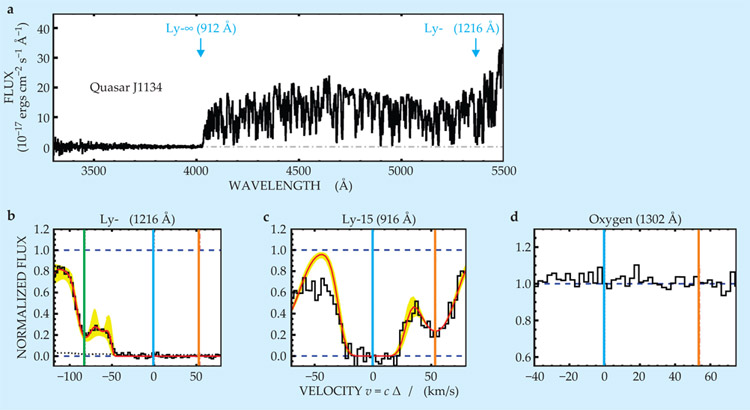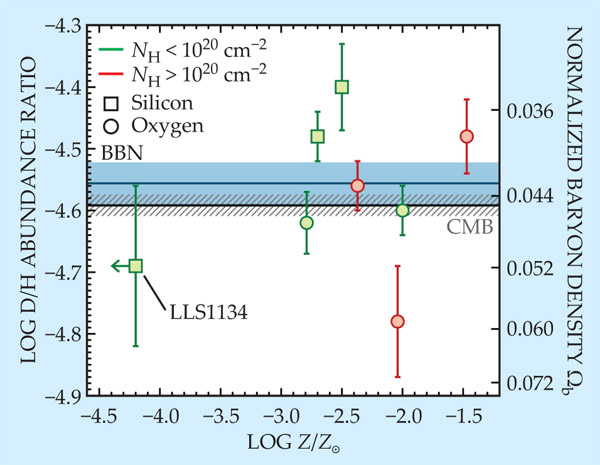A first glimpse of possibly primordial intergalactic gas
DOI: 10.1063/PT.3.1384
Hydrogen, helium, and a minuscule trace of lithium are the only elements left over from the first minutes after the Big Bang, 13.7 billion years ago. The creation of all heavier elements, collectively called “metals” in astrophysicists’ shorthand, had to await the coming of the first stars a few hundred million years later. So first-generation stars formed from pristine clouds of H and He. Only with their deaths was the cosmos first seeded with the metals they created.
So goes the standard theory of Big Bang nucleosynthesis (BBN). It’s been impressively confirmed by the agreement between the predicted and measured cosmic abundance ratios of the various H and He isotopes (see PHYSICS TODAY, August 1996, page 17
Metallicity, the quantitative measure of nonprimordial material in a star or gas cloud, is defined as the fraction of the system’s mass contributed by elements heavier than helium. The metallicity Z of an intergalactic gas cloud can be measured by looking at telltale absorption lines in the continuum UV spectrum of a background quasar viewed through the cloud. The oldest quasars suitable for this task date back to within a billion years of the Big Bang. And yet none of the clouds thus examined revealed a metallicity less than 10−3 of Z⊙, the Sun’s metallicity. “This apparent metallicity floor, for both gas and the oldest stars, was so puzzling,” says cosmologist Avi Loeb (Harvard University), “that some of us began to worry about the BBN model.”
Now, however, a team led by Xavier Prochaska (University of California, Santa Cruz) has reported the detection of two intergalactic clouds of apparently pristine, zero-metallicity gas. 1 Using the high-resolution spectrometer on the 10-meter Keck I telescope in Hawaii, they found two high-redshift clouds that show no metal absorption lines whatsoever despite spectroscopic sensitivity down to 10−4 Z⊙. So even if those clouds are not in fact pristine, their metal abundances are smaller, by at least an order of magnitude, than any previously seen.
The two clouds, though far apart on the sky, both have redshifts z (not to be confused with metallicity Z) near 3.3, which means that they’re being seen as they were about 2 billion years after the Big Bang. By then, most of the first-generation stars, presumed to have been much more massive than the Sun, would long since have died in supernovae, spewing out the metals they made. In any case, the quasars that shine through those apparently pristine clouds make clear that the clouds postdate a lot of galaxy formation.
So the new discovery bespeaks a surprisingly inhomogeneous distribution of the products of stellar nucleosynthesis in the early cosmos. And the clouds apparently untouched by that uneven dispersal provide cosmologists with a unique measurement of the primordial deuterium/hydrogen abundance ratio—a key BBN parameter—from an enclave unsullied by stellar processes.
Telltale absorption lines
Prochaska, his graduate student Michele Fumagalli, and John O’Meara (St. Michael’s College, Colchester, Vermont) had been spectroscopically observing high-z Lyman-limit systems to study the evolving metallicity of intergalactic gas in early epochs of star formation. An LLS is an intergalactic accumulation of gas with an atomic-hydrogen column density of order 1017–1019 cm−2 through which one sees a background quasar. That range of column densities is particularly favorable for measuring intergalactic metallicity.
Figure 1a shows the absorption-riddled continuum emission spectrum of the background quasar in LLS1134—the more informative of the two LLS’s reported in the team’s new paper. Because the system’s foreground absorber is at z = 3.41, the wavelengths of all the absorption features are stretched by a factor (1 + z) from the UV into the visible.

Figure 1. Continuum UV emission spectrum of a quasar seen through a Lyman-limit system (LLS1134) of absorbing foreground clouds at redshift z = 3.41. (a) The highly redshifted spectrum has many lines due to absorption in the LLS. But the cutoff at 4022 Å shows the signature LLS opacity to all wavelengths shorter than hydrogen’s Lyman-series limit (Ly-∞) of 912 Å in the absorber’s rest frame. (b) Magnification of the spectrum around the 1216 Å Ly-α line (blue) in cloud A, the stronger absorber of the two that constitute this LLS. Wavelength is here labeled in terms of recessional velocity relative to cloud A. The orange line marks the center of Ly-α absorption in cloud B, redshifted about 1 Å by the cloud’s 54 km/s recession. The green line marks deuterium’s isotope-shifted Ly-α line in cloud A. The curves show fits to absorption line shapes. (c) Same as (b) for hydrogen’s weaker Ly-15 absorption lines in the two clouds. (d) At the position of a usually prominent oxygen line, no absorption is seen in either cloud. (Adapted from ref.

The characteristic signature of an LLS, clearly seen in figure 1a, is the system’s complete opacity to all photons more energetic than Ly-∞, the limiting energy of the Lyman series of UV atomic-hydrogen spectral lines. In the absorbing system’s rest frame, the Ly-∞ wavelength is 912 Å, corresponding to hydrogen’s 13.6 eV ionization energy.
Lyman-α, the strongest and most important of the Lyman absorption lines, marks the 10.2-eV Ly-α excitation from the H ground state to the first excited state. In the LLS1134 absorption spectrum, it’s redshifted from 1216 Å, its rest-frame wavelength, to 5354 Å. The Ly-α line’s precise position in the highly redshifted spectrum serves as a reference for identifying the other absorption lines of interest.
With the Keck I spectrometer’s sub-angstrom resolution, the team was able to resolve individual Lyman absorption lines in LLS1134 all the way up to Ly-22. But model fitting of the line shapes showed each one to be a pair: a stronger absorption line with a weaker partner redshifted by only about 1 Å. The most straightforward interpretation of that doubling is that LLS1134 is really the superposition of a pair of separate clouds along the line of sight, the farther one (cloud B) receding from its more absorbing partner (cloud A) at a velocity of 54 km/s, corresponding to a tiny Δz of about 0.001 in the general cosmic expansion.
In that spirit, the magnified absorption spectrum near Ly-α and Ly-15 shown in figures 1b–c is plotted in terms of velocity v = cΔλ/λ. Zero velocity marks the spectral position of the line in cloud A. In each panel, a second absorption line, 54 km/s redward, is due to the same Lyman transition in cloud B. The strong Ly-α absorption is nearly total in both clouds, forming a continuous black trough. But the Ly-15 transition in cloud B yields only a shallow trough.
Deuterium but no metals
Figure 1b also exhibits a shallow trough, centered at v = −82 km/s. But that feature has nothing to do with clouds in relative motion. Instead it records Ly-α absorption in cloud A’s small admixture of deuterium. The 82-km/s blueshift simply manifests the tiny isotope shift that makes the Ly-α excitation energy 0.03% bigger in D than in ordinary H. Cloud B yields no useful D absorption features.
From the depths of D absorption lines, the team concludes the D/H abundance ratio in cloud A is 10−4.7±0.1. That’s not inconsistent with the average based on earlier measurements in half a dozen other low-metallicity clouds. Nor does the new measurement sport the smallest quoted uncertainty. It’s noteworthy principally because it’s the first D/H measurement in a system that might be pristine.
Despite the high sensitivity of the observations, cloud A revealed no absorption by metals. For example, figure 1d shows no discernable absorption at either the A or B spectral position of a usually prominent oxygen absorption line. But cloud B is clearly not pristine; it did exhibit some absorption by silicon and carbon. All the cloud A absorption lines, however, were attributable to H and its one stable heavy isotope. The undoubtedly significant He component in both clouds is not seen at optical frequencies because all its excitations remain in the UV even at these high redshifts.
“It’s quite possible that the first generation of stars produced nothing heavier than oxygen,” says Santa Cruz theorist Stan Woosley. “So I’m particularly impressed by the lack of carbon and oxygen.”
Fumagalli and coworkers place an upper limit of 10−4.2Z⊙ on the metallicity of cloud A. The other apparently metal-free cloud, found by the team in a different LLS, has only about 15% of cloud A’s column density. So its upper metallicity limit, 10−3.8Z⊙, is somewhat weaker.
Though each cloud, perhaps 100 light-years thick, was several orders of magnitude denser than the cosmic mean of 10−5 H atoms per cm3 in that epoch, neither is thought to have been dense enough to form late first-generation stars. “But they may well be our first sighting of the so-called cool flows predicted by computer simulations of that epoch,” says Prochaska. Those would be filamentary intergalactic streams of moderately dense, low-metallicity gas that flow into galactic halos and replenish the gas that sustains star formation. 2
The primordial isotope ratio
The primordial D/H abundance ratio is particularly important to cosmologists because its predicted value depends sensitively on the cosmic mean baryon density. That density, usually given as Ωb, the fraction of all mass and energy attributed to ordinary baryonic matter, is determined from cosmic-microwave-background (CMB) measurements to be (4.5 ± 0.1)%. (See PHYSICS TODAY, April 2003, page 21
Stars can destroy D. So a long-standing question had been whether direct measurements of D/H in high-z clouds with small but nonzero metallicity reliably represent the primordial ratio. Figure 2 compares the CMB prediction with a variety of measurements at different metallicities, including the new measurement in LLS1134. They are all seen to be consistent, with no trend attributable to stellar destruction.

Figure 2. The primordial deuterium/hydrogen abundance ratio predicted from cosmic-microwave-background (CMB) data (hatched bar) is compared with direct measurements in a variety of high-redshift clouds, plotted as a function of their metallicities Z. The new LLS1134 datum has only an upper limit on Z. The right-hand axis translates D/H into cosmic baryon density according to Big Bang nucleosynthesis (BBN) theory, and the blue bar shows the new world average of D/H measurements. The measurements are consistent with the CMB baryon-density determination and with each other. There’s no evident dependence of measured D/H on a cloud’s hydrogen column density NH, its Z, or the heavy element on which the Z measurement is primarily based. (Adapted from ref.

“So we can now conclude,” says Fumagalli, “that deuterium abundances from quasar absorption-line systems are solid anchor points for models of galactic chemical evolution.”
References
1. M. Fumagalli, J. M. O’Meara, J. X. Prochaska, Science 334, 1245 (2011). https://doi.org/10.1126/science.1213581
2. A. Dekel et al., Nature 457, 451 (2009).https://doi.org/10.1038/nature07648
